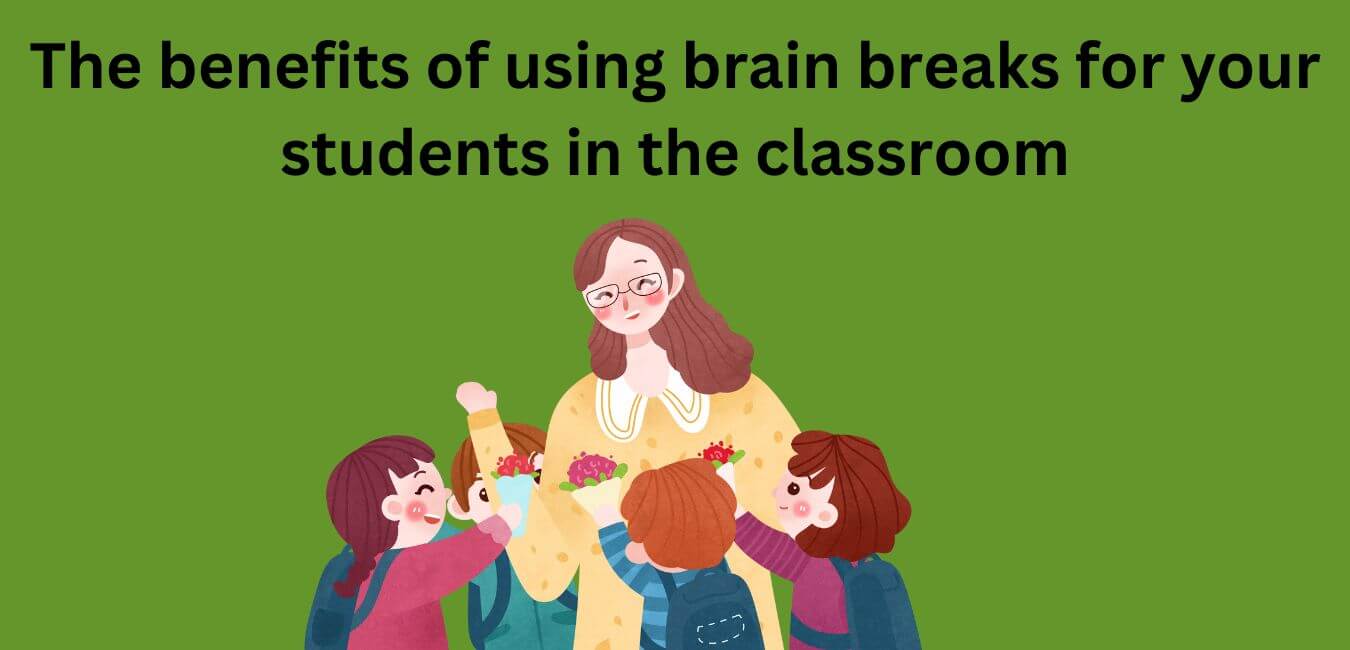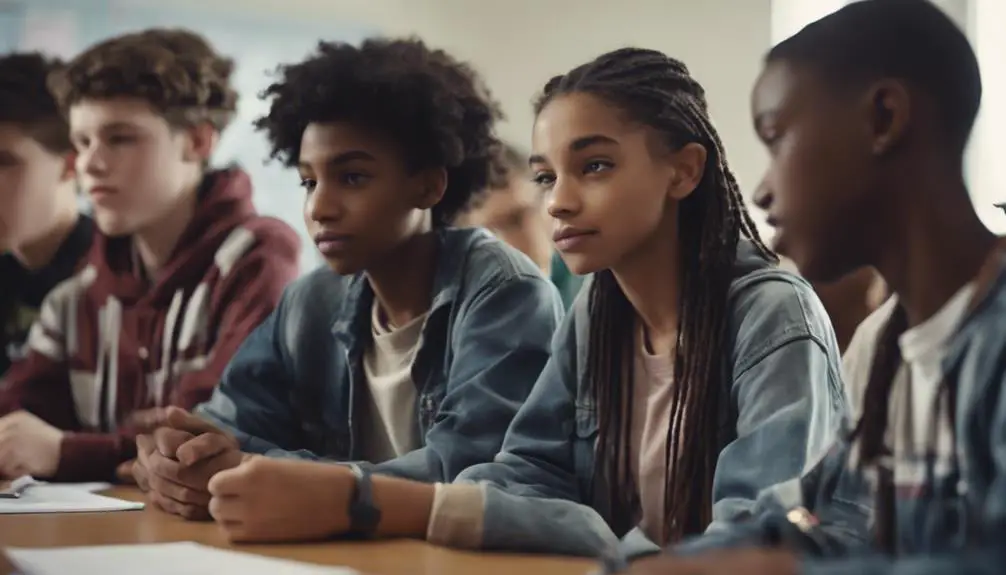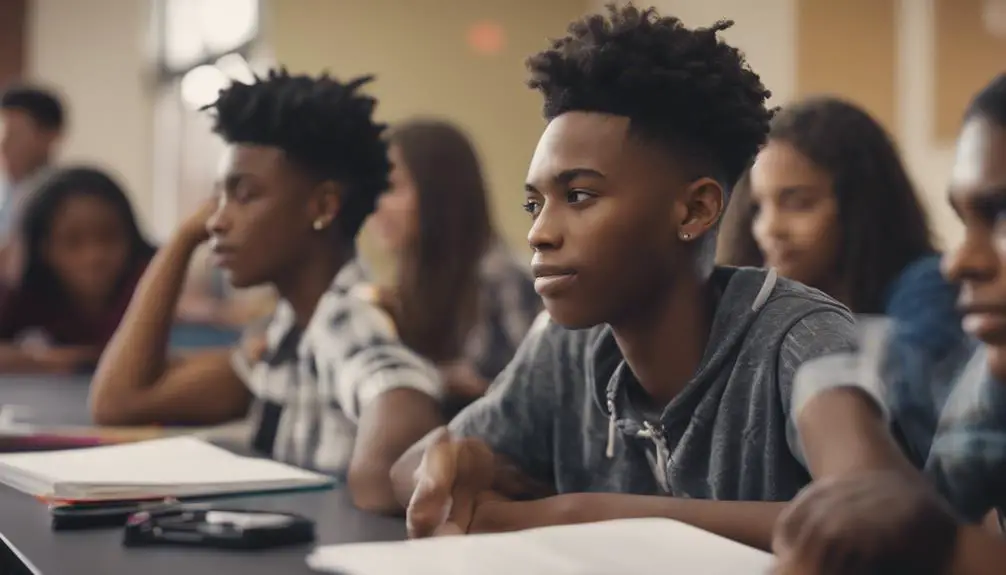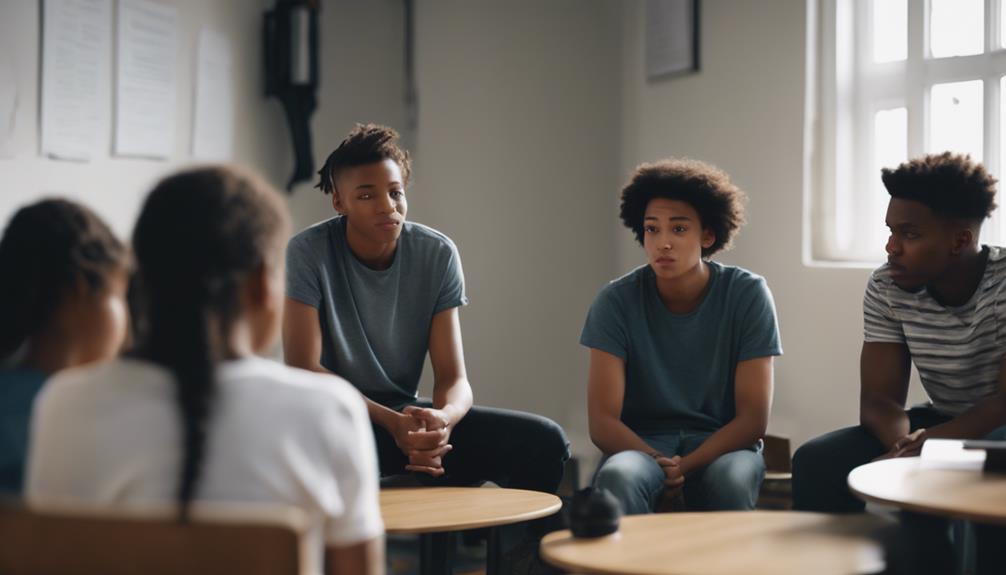As a teacher, it’s not uncommon to occasionally lose your cool in the classroom. It happens to the best of us! However, what’s important is how we respond after these moments.
In the following sections, we will explore various strategies and techniques that can help us regain control of the classroom after losing our cool.
These strategies include using humor to diffuse tension, revisiting classroom rules, teaching conflict resolution strategies, promoting empathy and understanding, and practicing active listening.
By implementing these strategies, we can create a positive and supportive learning environment for our students.
Take a deep breath
Taking a deep breath is a simple yet powerful technique that can help you regain control of your emotions and respond more effectively in the classroom. When you find yourself in a situation where you’ve lost your cool, it’s important to pause and take a moment to breathe deeply. This allows you to step back from the immediate stress or frustration and create space for a calmer mindset.
By taking a deep breath, you give yourself the opportunity to regain composure and think more clearly. It helps to slow down your heart rate and activate the relaxation response in your body. This can help to reduce feelings of anger or anxiety, allowing you to approach the situation with a clearer mind and a more measured response.
In addition to its physiological benefits, taking a deep breath also sends a powerful message to your students. It shows them that you are aware of your emotions and are taking steps to manage them in a healthy way. This can serve as a valuable lesson for your students, teaching them the importance of self-regulation and emotional intelligence.
So, the next time you feel yourself losing your cool in the classroom, remember to take a deep breath. It’s a simple yet effective strategy that can help you regain control, respond more thoughtfully, and create a positive learning environment for your students.
Apologize sincerely
When you lose your cool in the classroom, it’s important to acknowledge your mistake and apologize sincerely to the students involved. By doing so, you not only take responsibility for your actions but also teach them a valuable life lesson about accountability.
Start by addressing the students directly and expressing your regret for your behavior. Use clear and concise language to convey your sincerity. Avoid making excuses or shifting blame onto others. Instead, focus on taking ownership of your actions and the impact they had on the students.
It’s important to emphasize that everyone makes mistakes, including teachers. By apologizing sincerely, you show your students that it’s okay to admit when you’re wrong and to take steps to make amends. This helps to create a safe and supportive classroom environment where students feel comfortable expressing their own emotions and learning from their mistakes.
In addition to apologizing to the students involved, consider apologizing to the entire class. This demonstrates your commitment to creating a positive learning environment for everyone and reinforces the importance of respect and empathy.
Remember, a sincere apology goes beyond just saying the words. It involves reflecting on your actions, understanding the impact they had, and making a genuine effort to change your behavior moving forward. By modeling accountability, you set a powerful example for your students and foster a culture of understanding and growth in your classroom.
Reflect on your actions
After losing your cool in the classroom, it’s important to take some time to reflect on your actions. This self-reflection allows you to gain insight into what led you to lose control and helps you prevent similar situations in the future. By identifying triggers or patterns, you can develop strategies to manage your emotions and respond more effectively in challenging situations.
Start by asking yourself some key questions. What were the specific events or behaviors that triggered your reaction? Were there any underlying factors, such as stress or fatigue, that contributed to your emotional response? Reflecting on these factors can help you understand the root causes of your behavior and make necessary changes to prevent future outbursts.
Consider keeping a journal to document your reflections. Write down the details of the incident, your emotions, and any thoughts or insights that arise during your reflection. This practice can help you gain clarity and develop a deeper understanding of your triggers and reactions.
In addition to self-reflection, seek feedback from trusted colleagues or mentors. They can provide valuable insights and perspectives that you may have overlooked. Their feedback can help you gain a more comprehensive understanding of the situation and offer guidance on how to improve your response in the future.
By taking the time to reflect on your actions, you demonstrate a commitment to personal growth and professional development. This self-awareness allows you to make positive changes and create a more positive and supportive learning environment for your students.
Create a safe space for open discussion
To create a safe space for open discussion after losing your cool in the classroom, it’s important to encourage an open dialogue about what happened. By allowing students to express their feelings and concerns, you can foster a sense of trust and create a supportive community in the classroom.
Start by acknowledging the incident and its impact on the students. Let them know that their feelings are valid and that you are open to hearing their perspectives. Create a non-judgmental environment where students feel comfortable sharing their thoughts and emotions.
During the discussion, actively listen to each student and validate their experiences. Show empathy and understanding, and avoid interrupting or dismissing their concerns. This will help students feel heard and valued.
Encourage students to express their emotions in a respectful manner and provide guidance on how to communicate effectively. Teach them conflict resolution strategies, such as using “I” statements and active listening, to promote constructive dialogue.
As the teacher, it’s important to model vulnerability and accountability. Share your own reflections on the incident and apologize if necessary. This demonstrates that everyone makes mistakes and that it’s important to take responsibility for our actions.
By creating a safe space for open discussion, you empower students to voice their feelings and concerns. This not only helps them process the incident but also fosters a positive and inclusive classroom environment where everyone’s perspectives are valued.
Offer individual apologies
In addition to creating a safe space for open discussion, it is important to offer individual apologies to any students who were directly affected or upset by your loss of control in the classroom. Taking the time to privately apologize shows them that you genuinely care about their feelings and are committed to making amends.
When offering individual apologies, approach each student with empathy and sincerity. Begin by acknowledging the impact your actions had on them and express your regret for any distress caused. Use active listening skills to understand their perspective and validate their emotions. This demonstrates that you value their feelings and are willing to take responsibility for your behavior.
During the apology, avoid making excuses or shifting blame. Instead, focus on expressing genuine remorse and a commitment to improving your actions in the future. This helps rebuild trust and shows students that you are actively working towards creating a positive and respectful learning environment.
Remember to maintain confidentiality during these conversations, as some students may prefer to keep the details private. Respect their boundaries and reassure them that their feelings are valid and important.
By offering individual apologies, you demonstrate your willingness to take accountability for your actions and prioritize the emotional well-being of your students. This personal approach helps rebuild trust and fosters a sense of respect and understanding within the classroom.
Use humor to diffuse tension
Using humor to diffuse tension in the classroom is a powerful tool for regaining control and creating a positive learning environment. When tension arises, a well-timed joke or funny anecdote can quickly lighten the mood and shift the focus away from negative emotions.
Humor has the ability to break down barriers and create a sense of connection between students and teachers. It allows everyone to relax and let go of any lingering tension. By injecting humor into the classroom, you can create a more enjoyable and engaging atmosphere for both you and your students.
However, it’s important to use humor appropriately and sensitively. Avoid jokes that may be offensive or hurtful to any individual or group. Instead, focus on light-hearted and inclusive humor that can be enjoyed by everyone.
One way to incorporate humor is by sharing funny stories or experiences related to the topic being discussed. This not only lightens the mood but also helps to make the content more relatable and memorable for students.
Additionally, you can encourage students to share their own funny stories or jokes, creating a collaborative and interactive environment. This not only promotes a positive classroom culture but also allows students to feel more comfortable expressing themselves.
By using humor to diffuse tension, you can create a classroom environment that is conducive to learning, collaboration, and positive relationships. So, don’t be afraid to embrace the power of laughter in your classroom.
Revisit classroom rules
Taking the opportunity to review and reinforce the classroom rules is an essential step in regaining control after losing your cool. This not only reminds students of what is expected of them but also reinforces boundaries. By revisiting the rules, you can establish a sense of structure and order in the classroom, which is crucial for creating a positive learning environment.
During this process, it’s important to explain the rationale behind each rule and emphasize the importance of following them. This helps students understand the purpose of the rules and encourages them to take ownership of their behavior. Additionally, you can use real-life examples or scenarios to illustrate the consequences of not adhering to the rules, making it more relatable and impactful for students.
Furthermore, consider involving students in the discussion by asking for their input on the rules. This not only gives them a sense of ownership but also allows them to contribute to the creation of a respectful and inclusive classroom culture. Encourage them to suggest any additional rules they believe would be beneficial for maintaining a positive learning environment.
By revisiting and reinforcing the classroom rules, you establish clear expectations for behavior and create a sense of accountability among students. This helps to prevent future conflicts and disruptions, allowing for a more focused and productive learning experience. So, take the time to review and discuss the rules with your students, ensuring that everyone is on the same page and committed to creating a positive classroom environment.
Teach conflict resolution strategies
Explore effective ways of resolving conflicts in a respectful manner. By providing students with the tools to handle conflicts constructively, you help them develop important life skills. Conflict is a natural part of human interaction, and learning how to navigate it positively is crucial for personal growth and maintaining healthy relationships.
One strategy to teach conflict resolution is active listening. Encourage students to listen attentively to each other’s perspectives without interrupting or judging. This helps foster empathy and understanding, as students gain insight into different viewpoints. Another strategy is teaching assertiveness skills, empowering students to express their needs and concerns respectfully. This can be done through role-playing exercises or discussions on effective communication.
Additionally, promoting problem-solving skills is essential. Teach students how to identify the root causes of conflicts and brainstorm possible solutions. Encourage them to consider the consequences of their actions and find mutually beneficial outcomes. By involving students in the resolution process, they feel empowered and develop a sense of ownership over their actions.
Furthermore, emphasize the importance of compromise and negotiation. Teach students how to find common ground and reach agreements that satisfy both parties. This helps build collaborative skills and encourages cooperation.
By teaching conflict resolution strategies, you equip students with the tools to handle conflicts constructively and respectfully. These skills not only benefit their academic experience but also prepare them for future challenges in their personal and professional lives.
Promote empathy and understanding
Promote empathy and understanding by using this situation as a teachable moment in your classroom. Encourage your students to put themselves in each other’s shoes, fostering a supportive and empathetic classroom community.
One way to promote empathy is through perspective-taking activities. Assign students to research and present on a topic from a different perspective, encouraging them to understand different viewpoints and experiences. This helps them develop empathy by seeing the world through someone else’s eyes.
Another strategy is to incorporate literature or media that explores diverse experiences and perspectives. This can include books, movies, or articles that highlight different cultures, backgrounds, or social issues. Engage students in discussions about these materials, encouraging them to reflect on the characters’ experiences and how they relate to their own lives.
Additionally, create opportunities for students to share their personal experiences and stories. This can be done through class discussions, journaling, or small group activities. By sharing their stories, students can develop a deeper understanding of each other’s backgrounds and experiences, fostering empathy and connection.
Lastly, model empathy and understanding in your own interactions with students. Show genuine care and concern for their well-being, and actively listen to their thoughts and feelings. By modeling empathy, you set a positive example for your students and create a safe space for open and respectful communication.
By promoting empathy and understanding, you create a classroom environment where students feel valued and supported, leading to improved relationships and a more positive learning experience.
Practice active listening
Practice active listening is a crucial skill for teachers to cultivate to regain control and rebuild trust in the classroom. By actively listening to students’ concerns, teachers can ensure that students feel heard and valued. This creates a safe and supportive environment where open communication can thrive.
To practice active listening, start by giving your full attention to the student speaking. Maintain eye contact, nod your head to show understanding, and avoid interrupting. This demonstrates respect and validates their feelings.
Additionally, paraphrase and summarize what the student has said to show that you are actively engaged in the conversation. This not only helps you understand their perspective better but also shows the student that you are genuinely listening and trying to comprehend their point of view.
Furthermore, ask open-ended questions to encourage students to elaborate on their thoughts and feelings. This allows for a deeper exploration of the issue at hand and shows that you are interested in understanding their perspective fully.
Finally, avoid judgment or defensiveness when students express their concerns. Instead, respond with empathy and understanding. Acknowledge their feelings and validate their experiences, even if you may not agree with them.
By practicing active listening, teachers can create an inclusive and supportive classroom environment where students feel heard and respected. This fosters positive relationships and paves the way for effective conflict resolution and open communication.
Share personal experiences
Sharing personal experiences can be a powerful way to connect with students and demonstrate vulnerability. If appropriate, share a personal experience where you learned from losing your cool. By sharing your own mistakes and reflecting on how you responded, you can help students realize that everyone makes mistakes and it’s how we respond that matters.
When sharing a personal experience, choose one that is relatable to the situation at hand. This will help students see the parallels between your experience and theirs, making it easier for them to empathize and understand. Use this opportunity to highlight the emotions you felt during that moment and how you managed to regain control.
By sharing your personal experience, you are not only showing students that you are human but also modeling the behavior you expect from them. This can create a safe space for open discussion and encourage students to share their own experiences and reflections.
Remember to emphasize the importance of learning from mistakes and growing as individuals. Encourage students to reflect on their own actions and consider how they can respond differently in similar situations. By sharing personal experiences, you can inspire students to take ownership of their behavior and strive for personal growth.
Incorporating personal experiences into your teaching can foster a sense of connection and trust between you and your students. It allows for a more authentic and meaningful learning experience, where students feel seen, heard, and understood.
Seek feedback from colleagues
Seeking feedback from colleagues is an important step in regaining control after losing your cool in the classroom. Discussing the incident with trusted colleagues who can provide their perspectives and offer advice can help you gain valuable insights and learn from the experience. By sharing your experience with others, you can benefit from their wisdom and expertise, which can ultimately help you grow as an educator.
When seeking feedback from colleagues, it’s important to choose individuals whom you trust and respect. Look for colleagues who have experience in similar situations or who have a good understanding of classroom dynamics. Their insights can provide you with a fresh perspective and help you see the incident from different angles.
During these discussions, be open and receptive to feedback. Listen to their observations and suggestions without becoming defensive. Remember that the purpose of seeking feedback is to learn and improve, not to justify your actions. Consider their perspectives and reflect on how their insights align with your own observations.
In addition to gaining insights, seeking feedback from colleagues can also provide emotional support. Knowing that you are not alone in facing challenges can be reassuring and help you feel understood. Colleagues can offer encouragement and share their own experiences, creating a sense of camaraderie and solidarity.
By seeking feedback from colleagues, you are actively engaging in professional development and demonstrating a commitment to continuous improvement. Embrace the opportunity to learn from others and use their feedback to inform your future actions in the classroom. Remember, seeking feedback is a sign of strength and a valuable tool for personal and professional growth.
Implement relaxation techniques
To regain control after losing your cool in the classroom, it is important to teach students relaxation techniques. By introducing them to techniques such as deep breathing exercises, mindfulness, or stretching, you can provide them with valuable tools to manage stress and diffuse tense situations.
Deep breathing exercises can be particularly effective in helping students calm their minds and bodies. Encourage them to take slow, deep breaths, inhaling deeply through their nose and exhaling slowly through their mouth. This simple technique can help reduce anxiety and promote a sense of calmness.
Mindfulness exercises can also be beneficial in helping students regain control. Teach them to focus their attention on the present moment, without judgment or attachment to their thoughts or emotions. This practice can help students become more aware of their feelings and reactions, allowing them to respond to challenging situations in a more thoughtful and composed manner.
Additionally, incorporating stretching exercises into the classroom routine can help students release tension and relax their muscles. Encourage them to stretch their arms, legs, and neck, and guide them through simple stretching routines. This can not only help them physically relax, but also provide a mental break and shift their focus away from the stressful situation.
By implementing relaxation techniques in the classroom, you are equipping students with valuable coping mechanisms that they can use throughout their lives. These techniques can help them manage stress, regulate their emotions, and ultimately contribute to a more positive and harmonious classroom environment.
Set clear expectations
To regain control after losing your cool in the classroom, it is crucial to set clear expectations for your students moving forward. Communicate what you expect from them in terms of behavior and academic performance. By doing so, you establish a framework that promotes a positive and respectful learning environment.
One way to set clear expectations is by outlining the consequences of inappropriate behavior. Make sure your students understand the potential outcomes of their actions, whether it’s a warning, loss of privileges, or a discussion with their parents. This helps them understand the boundaries and encourages them to make better choices.
Emphasize the importance of mutual respect in the classroom. Teach your students that everyone deserves to be treated with kindness and understanding. Encourage them to listen to each other’s perspectives, value diversity, and practice empathy. By fostering a culture of respect, you create an environment where students feel safe and supported.
In addition to verbal communication, consider using visual aids or written reminders to reinforce your expectations. Display classroom rules prominently and refer to them when necessary. This visual reinforcement helps students remember what is expected of them and serves as a gentle reminder when they veer off track.
By setting clear expectations, you provide your students with a roadmap for success. They know what is expected of them and understand the consequences of their actions. This clarity helps to restore order and create a positive learning environment where everyone can thrive.
Plan engaging activities
Plan engaging activities that capture students’ attention and ignite their curiosity. By incorporating interactive and hands-on lessons, you can create a dynamic learning experience that keeps students engaged and motivated.
One effective strategy is to incorporate technology into your lessons. Use educational apps, online resources, or interactive whiteboards to make the content more interactive and visually appealing. This not only enhances students’ understanding but also makes learning fun and exciting.
Another way to plan engaging activities is to incorporate group work and collaborative projects. Assign tasks that require students to work together, solve problems, and communicate effectively. This not only promotes teamwork but also encourages active participation and engagement.
Consider incorporating real-world examples and practical applications of the concepts being taught. This helps students see the relevance and importance of what they are learning, making it more meaningful and engaging.
Furthermore, incorporate hands-on activities and experiments that allow students to explore and discover concepts on their own. This fosters a sense of curiosity and ownership over their learning, making it more engaging and memorable.
By planning engaging activities, you create a classroom environment that is exciting and stimulating. Students are more likely to be actively involved in their learning, leading to improved behavior and a positive classroom atmosphere.
Foster positive relationships
Foster positive relationships with your students by going beyond the role of an educator and showing genuine interest in their lives. Take the time to get to know each student individually, their interests, hobbies, and aspirations. This not only helps you connect with them on a personal level but also shows that you care about their well-being.
Creating a supportive classroom culture is essential for fostering positive relationships. Encourage open communication and create a safe space where students feel comfortable expressing their thoughts and opinions. This can be achieved by implementing class meetings or circle time, where students can share their experiences, concerns, and ideas.
In addition, promote collaboration and teamwork among students. Assign group projects or activities that require them to work together towards a common goal. This not only helps build positive relationships between students but also teaches them important skills such as communication, problem-solving, and empathy.
Another way to foster positive relationships is by providing constructive feedback and praise. Recognize and acknowledge students’ efforts and achievements, both academically and behaviorally. This helps boost their self-esteem and motivates them to continue working hard.
By fostering positive relationships with your students, you create a supportive and inclusive classroom environment. Students feel valued, respected, and connected, which in turn leads to improved behavior and a more positive learning experience for everyone involved.
Forgive yourself
As an educator, it’s important to remember that teachers are humans too. We all make mistakes, and losing your cool in the classroom is no exception. It’s crucial to learn from these mistakes and forgive yourself in order to move forward and create a positive learning environment for your students.
Reflect on the situation and acknowledge what went wrong. Understand that everyone has moments of frustration or anger, and it’s natural to react in ways we later regret. By recognizing your emotions and actions, you can take steps to prevent similar situations in the future.
Forgiving yourself is an essential part of personal growth and development. Holding onto guilt or shame can hinder your ability to effectively teach and connect with your students. Remember that every day is a new opportunity to become a better educator. Use your past experiences as lessons to improve your teaching strategies and classroom management skills.
Seek support from colleagues or mentors who can provide guidance and perspective. Discussing your challenges and seeking advice from others who have been in similar situations can help you gain new insights and strategies for handling difficult moments in the classroom.
By forgiving yourself, you demonstrate resilience and a commitment to personal growth. Embrace the opportunity to learn from your mistakes, make amends if necessary, and move forward with a renewed sense of purpose and dedication to your students’ success.
Conclusion
Losing your cool in the classroom happens to everyone, but how we respond afterward is what truly matters. It’s important to remember that our actions have a lasting impact on our students, and it’s our responsibility to create a positive learning environment for them.
In conclusion, responding after losing your cool requires reflection, self-forgiveness, and a commitment to personal growth. Reflecting on the situation allows us to understand what went wrong and how we can prevent similar incidents in the future. It’s crucial to acknowledge our emotions and actions, and to seek support from colleagues or mentors who can provide guidance and perspective.
Self-forgiveness is essential for our own well-being and for the well-being of our students. Holding onto guilt or shame can hinder our ability to effectively teach and connect with them. By forgiving ourselves, we demonstrate resilience and a commitment to personal growth.
Moving forward, we can use our past experiences as lessons to improve our teaching strategies and classroom management skills. We can create a safe space for open discussion, teach conflict resolution strategies, promote empathy and understanding, and foster positive relationships with our students.
Remember, every day is a new opportunity to become a better educator. By responding to our mistakes with reflection, self-forgiveness, and a commitment to personal growth, we can regain control of our classrooms and create a positive and nurturing learning environment for our students.

















